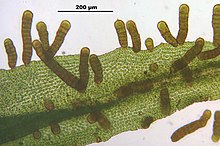Lyell's golden hair moss
| Lyell's golden hair moss | ||||||||||||
|---|---|---|---|---|---|---|---|---|---|---|---|---|

Lyell's golden hair moss ( Orthotrichum lyellii ) |
||||||||||||
| Systematics | ||||||||||||
|
||||||||||||
| Scientific name | ||||||||||||
| Orthotrichum lyellii | ||||||||||||
| Hook. & Taylor |
Lyell's golden hair moss ( Orthotrichum lyellii ) is a deciduous moss species from the Orthotrichaceae family , named after the Scottish botanist Charles Lyell . It is one of the largest European Orthotrichum species, almost always grows on trees and is easy to distinguish from other mosses in the terrain thanks to the numerous breeding bodies on the leaves .
Identifying features
This species forms strong, loose, yellow-green to brownish lawns. The usually arching stems are 2 to 4 centimeters high, rarely even higher. The leaves are linear-lanceolate, long and finely pointed, keeled and 3 to 4 millimeters long. Your rib extends to the tip of the leaf. When dry, the leaves lie loosely on the stem, when moistened they protrude or bend back. Most of the leaves are covered with numerous conspicuous brood bodies, these are red-brown, single-row, cylindrical or club-shaped, sometimes also branched.
The leaf cells are long rectangular to linear at the leaf base near the rib, too square towards the leaf edge. Above the leaf base they are roundish-oval, thick-walled, around 10 to 15 µm in size. The leaf cells have a long papilla on both sides.
The reproduction mostly takes place through the mentioned brood bodies. The species is diocesan . The spore capsule on the 1 millimeter long seta is completely or partially sunk into the leaves, oval-elongated, eight-ribbed, with phaneroporous stomata in the lower capsule area. The double peristome consists of 16 teeth and 16 eyelashes. The kalyptra is conical and sparsely hairy.
Distribution and location requirements
Lyell's golden hair moss is a sub-oceanic-sub-Mediterranean species and is common in the Northern Hemisphere excluding Central and East Asia.
The moss grows epiphytically on deciduous trees, less often on conifers. Rocks, walls or concrete piles are only populated occasionally. Common companion mosses are Orthotrichum affine , Leucodon sciuroides , Frullania dilatata , Radula complanata and Ulota species.
literature
- Ruprecht Düll , Barbara Düll-Wunder: Determine mosses easily and reliably. An illustrated excursion guide to the types of Germany and neighboring countries. Quelle & Meyer, Wiebelsheim 2008, ISBN 978-3-494-01427-2 .
- Jan-Peter Frahm , Wolfgang Frey : Moosflora (= UTB . 1250). 4th, revised and expanded edition. Ulmer, Stuttgart 2004, ISBN 3-8252-1250-5 .
- Martin Nebel, Georg Philippi (ed.): The mosses of Baden-Württemberg. Volume 2: Special part, (Bryophytina II, Schistostegales to Hypnobryales). Ulmer, Stuttgart 2001, ISBN 3-8001-3530-2 .

